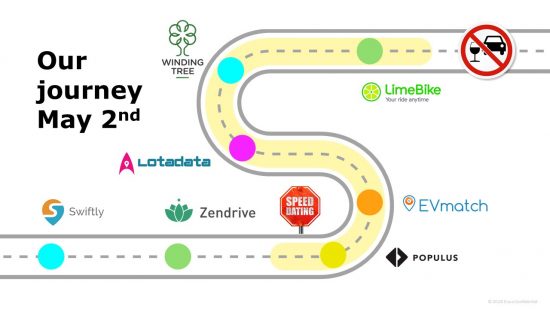
While I’m out on maternity leave, I’m excited to highlight the varied viewpoints of some of the amazing people that make up CHILL. I’m proud to work with this diverse and talented team. They hail from around the globe, and bring a rich set of experiences, skills, and passions to bear on everything they do. Today’s guest blogger is Katie Delgado, who manages much of the preparation and delivery of our CHILL Living Labs. She shares insights gained during a recent “Learning Journey” with customers.
An innovation project never starts with a blank slate. In Cisco CHILL, we’re best known for our 48-hour Living Labs, but we don’t just decide to have lab, invite a few customers, and start innovating. We spend six to 12 months learning and preparing first.
We dive into research, look at what Cisco and our customers are doing, and try to find new opportunity areas for innovation. What are the broad industry challenges that demand bold solutions? What are the common challenges our customers face in these areas? What are other people doing in this space? Who are the innovators and leading-edge startups? Where is the “white space” where no one else is working? Where can industry-wide multiparty innovation truly make a difference?
We search for answers in many ways—reading academic research and industry publications, attending conferences, talking to customers. And when we have a pretty good idea of an area we’d like to explore, we take a Learning Journey. We invite a broad range of customers to join us for a day of learning about a particular issue. Then we get on a bus together to visit startups that are attacking various aspects of it.

Earlier this month, we took a Learning Journey with about 15 customers to explore the future of transport and mobility. We visited seven startups that are focused on specific areas of this space:
- Swiftly develops enterprise software to help transit agencies and cities improve urban mobility
- Zendrive uses smartphone sensors and machine learning to help improve driver safety
- Populus is building a data platform to help cities and private mobility operators deliver safer and more efficient streets
- EVmatch fills a gap in the electric vehicle charging infrastructure by connecting EV drivers with privately owned charging stations
- Lotadata transforms mobile signals into real-time insights about why people are where they are and what they might do next
- Winding Tree is a decentralized blockchain-based travel platform that makes travel cheaper for individual travelers and more profitable for providers
- LimeBike provides first- and last-mile transportation to help people reduce their carbon footprint while moving around cities in an affordable, convenient way
So what did we learn?
Well, first of all, we saw that there’s a lot of exciting innovation going on—and data analytics seems to be the hot spot. While people might think first of autonomous vehicles when considering the future of transport, we saw quite clearly that it’s all about the data. Smartphones, city transit systems, ridesharing apps, and autonomous cars are generating unimaginable amounts of data. The big question is, what to do with it? The startups we visited are helping to answer that question.
We see the industry accelerating at the speed of startup—and that’s what we love to see.
 The second big thing we wanted to learn is, where do CHILL and Cisco fit? What is the play for a large enterprise? Where is there opportunity for multiple enterprise players to come together to significantly move the industry? The Learning Journey helped us clarify what to do next. We see the industry accelerating at the speed of startup—and that’s what we love to see. It’s moving on its own, so we’re going to pivot to another arena that could use CHILL’s secret sauce to disrupt and transform.
The second big thing we wanted to learn is, where do CHILL and Cisco fit? What is the play for a large enterprise? Where is there opportunity for multiple enterprise players to come together to significantly move the industry? The Learning Journey helped us clarify what to do next. We see the industry accelerating at the speed of startup—and that’s what we love to see. It’s moving on its own, so we’re going to pivot to another arena that could use CHILL’s secret sauce to disrupt and transform.
This Learning Journey not only helped us clarify what we do and do not want to pursue, it also deepened relationships with customers and led to new insights. At the end of the day, a vice president of a major financial services firm said, “the CHILL methodology is really powerful. We actually need to stop what we’re doing and look at everything from a completely different perspective.” For this customer, the experience represented a different journey—from seeing innovation as a good thing, to seeing it as a business imperative.
And now, we’re moving on to our next area of exploration: the “circular economy.” Enterprises around the globe are beginning to understand that resources are not endlessly replaceable and that simply extracting what we need from the earth is not sustainable. The circular economy extracts resources from products we’ve already used, and repurposes them in new and innovative ways. In our next Learning Journey—coming this summer—we’ll be looking at the innovators in this space, and will learn alongside our customers where we might have an opportunity to move innovation forward. Are you in? Contact us at areyouin@cisco.com if you’d like to learn more.

Really interesting how CHILL leads these explorations with customers to identify where the CHILL secret sauce can be most useful. It's part of the process–exploring, engaging, learning, and continuing on to find value. Great blog post, Katie!